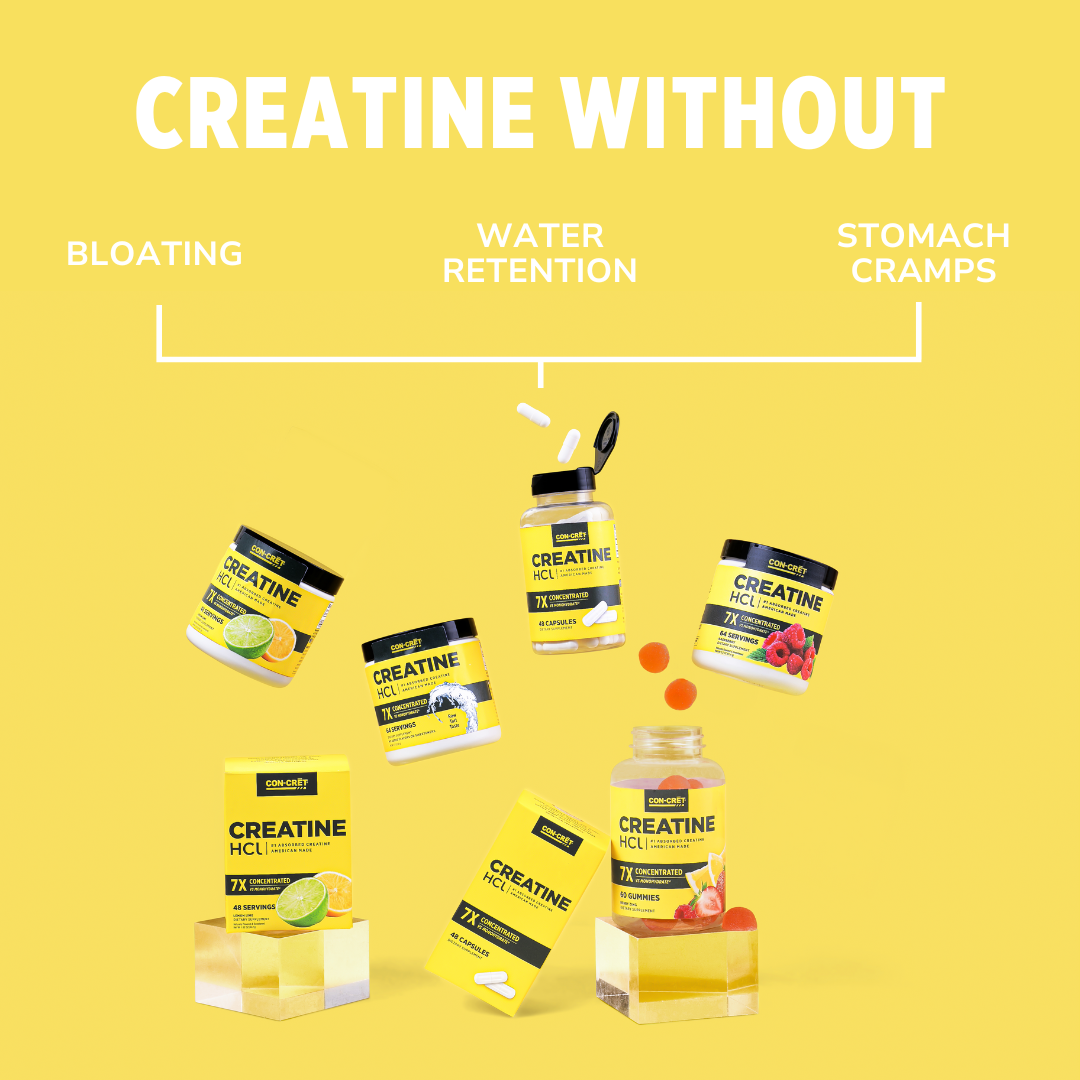
Key Takeaways:
- Creatine monohydrate is effective but requires bigger scoops, a loading phase, and may cause bloating.
- Creatine HCl absorbs faster, requires smaller doses, and is easier to digest — no loading, no puff.
- Both forms work, but HCl delivers the same gains with less hassle, especially for people sensitive to monohydrate.

Walk into any supplement aisle, and you face the same fork in the road: a scoop of creatine monohydrate on the left and a shiny jar of Creatine HCl on the right. Monohydrate has a 30-year track record, a wallet-friendly price tag, and enough studies to fill a small library. HCl counters with quick dissolve, micro-dosing, and a no-bloat guarantee that sounds like cheat-code science.
So, which one should actually land in your shaker bottle? At CON-CRĒT we like clear answers, not locker-room guesses. That’s why we put together this article: to line up the pros and cons in plain English and help you pick the creatine that fits your goals, your gut, and your budget.
Let’s find your perfect creatine match.
What Is Creatine Monohydrate?
Creatine monohydrate is the granddaddy of all creatines. One creatine molecule plus one water molecule, pressed into a coarse white powder.
When you mix it, the grainy bits you see are partially soluble crystals. Your gut eventually absorbs most of it, but the process is slow, so standard advice calls for a “loading phase” of 20 grams per day for a week, then 3 to 5 grams daily after that.
What Is Creatine HCl?
Creatine HCl bonds the same creatine molecule to a hydrochloride salt, turning those chunky crystals into fine powder that practically vanishes in water. Higher solubility means your body grabs it faster and wastes less. Most users hit their target with about 0.75 grams per 100 pounds of body weight and skip the loading week altogether.
Which One Delivers Better Results?
Here’s the truth: both forms work. They both get creatine into your muscles, boost ATP production, and support strength, performance, and recovery. So the results you can get are pretty equal on paper.
The difference is how efficiently those results show up for you. Creatine HCl’s high solubility may mean faster absorption and less waste, which can feel like quicker benefits, especially if you’ve struggled with monohydrate in the past.
But if you’re consistent with either one, hitting your dosage, and training hard? You’ll see gains. HCl just gets you there with less powder and fewer hoops to jump through.
What About Side Effects?
This is where the creatines start to split. Creatine monohydrate has the most reported side effects: water retention, some bloating, and mild stomach discomfort. That’s because it’s less soluble, so undissolved particles can sit in your gut and draw in water. It’s not dangerous, just annoying.

Creatine HCl, thanks to its solubility, is generally easier on your digestion. Fewer complaints about bloating, no need for bathroom sprints, and no “am I retaining water or just overhydrated?” guessing games. It’s not magic, just better absorption and lower volume.
If your stomach handles both just fine, great — pick your favorite. But if monohydrate’s been a gut-check before, HCl might be your peace treaty.
Tips for Everyday Use
Whether you’re scooping monohydrate or micro-dosing Creatine HCl, keep these tips in mind to lock in results and dodge the rookie mistakes.
Hydrate Without Drowning
Creatine pulls water into your muscle cells; that’s part of how it works. But if you’re not drinking enough, that process can leave you feeling sluggish or crampy. You don’t need to guzzle gallons, but aim for at least 64-80 ounces of water a day (more if you’re sweating buckets). Your muscles — and your digestion — will thank you.
Pair It With Carbs and Protein
Want your creatine to hit harder? Stack it with a little food. A banana, protein shake, or post-lift smoothie helps trigger insulin, which nudges more creatine into your muscle cells.
Try Gummies for Grab-and-Go
Not into mixing powder or dealing with grainy water? We get it. That’s why CON-CRĒT® Creatine HCl Gummies exist.
They’re 7x concentrated, clinically backed, and made to go wherever your day does — no shaker bottle required. Just three gummies get you your full daily dose, without the bloating or bathroom drama of traditional creatine. Easy. Effective. Actually tastes good.
Skip the Cycling Myth
You don’t need to “cycle off” creatine unless you want to. There’s no evidence that taking breaks makes it work better, and no harm in using it long-term if you’re healthy. If it’s working, keep going. Your gains don’t take vacations, and your supplements don’t need to either.
Frequently Asked Questions
Can I take Creatine HCl and monohydrate at the same time?
You can, but it’s like paying for two streaming services that play the same show; pick one, hit your daily dose, and call it good.
Does Creatine impact sleep quality?
No direct evidence says it ruins sleep, but late-night mega scoops plus caffeine can keep anyone wired. Take it earlier if you’re sensitive.
How should I store my Creatine?
Cool, dry, and airtight is the move. Humidity clumps powder and turns gummies into one giant brick — great for doorstops, not so great for dosing.
Conclusion
So, which should you be taking — monohydrate or HCl? If you’re cool with a bigger scoop, a loading phase, and don’t mind some possible puff, monohydrate gets the job done. But if you want faster absorption, smaller servings, and smoother digestion, Creatine HCl is the move.
At CON-CRĒT®, we’re team HCl all day. Why? Because it’s clean, clinically backed, and actually fits into real life. No bloat, no loading, no BS. Just results that speak for themselves.
Sources:
Creatine: What It Does, Benefits, Supplements & Safety | Cleveland Clinic
What Do Athletes Need to Know About Creatine? | USADA
Creatine Supplementation Increases Total Body Water Without Altering Fluid Distribution | PMC
